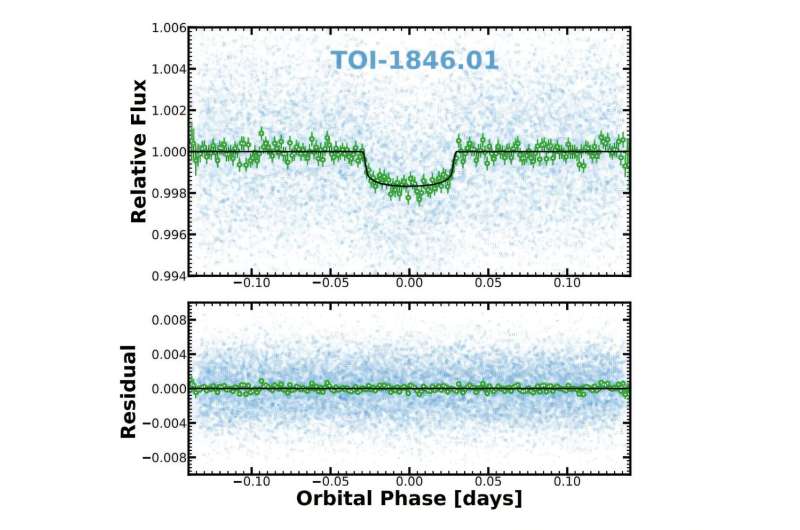In a groundbreaking discovery, an international team of astronomers has identified a new super-Earth exoplanet orbiting a nearby M dwarf star. The exoplanet, named TOI-1846 b, was detected using NASA’s Transiting Exoplanet Survey Satellite (TESS) and is approximately two times larger and four times more massive than Earth. This significant finding was detailed in a paper published on June 23, 2025, on the arXiv preprint server.
TESS, launched in April 2018, has been pivotal in the search for exoplanets, identifying over 7,600 candidate exoplanets, known as TESS Objects of Interest (TOI), with 636 confirmed to date. The satellite surveys around 200,000 of the brightest stars near the sun, seeking transiting extrasolar worlds. The recent discovery of TOI-1846 b was led by Abderahmane Soubkiou from the Oukaimeden Observatory in Morocco. The planet orbits its host star, located approximately 154 light years away, every 3.93 days at a distance of 0.036 AU.
Details of the Discovery
The astronomers validated the presence of TOI-1846 b through a combination of TESS data and ground-based photometric and spectroscopic observations. These efforts confirmed the planetary nature of the transit signal detected by TESS. According to the study, TOI-1846 b has a radius of about 1.792 Earth radii and a mass 4.4 times that of Earth, resulting in a density of 4.2 g/cm3. The equilibrium temperature of the planet is estimated to be 568.1 K.
The discovery places TOI-1846 b within the “radius valley,” a region in the radius distribution where there is a noticeable dip in the occurrence of planets. This area separates rocky super-Earths from gaseous sub-Neptunes, typically observed at around 1.8 Earth radii. The researchers suggest that TOI-1846 b is likely a water-rich super-Earth.
Implications for Future Research
The identification of TOI-1846 b opens new avenues for research, particularly in understanding its composition. The researchers emphasized the need for radial velocity (RV) observations to determine the planet’s mass more accurately. They noted that the MAROON-X instrument could be instrumental in this process. Additionally, the transmission spectroscopy metric (TSM) for TOI-1846 b was calculated to be 47, which is below the benchmark of 90 for small sub-Neptunes, indicating potential challenges in atmospheric characterization.
“These findings make TOI-1846 b well-suited for mass determination via RV observations,” the authors wrote.
The Host Star: TOI-1846
The parent star, TOI-1846, also known as TIC 198385543, is a relatively small star, about 0.4 times the size of the sun, with a mass of approximately 0.42 solar masses. It has an effective temperature of 3,568 K and is estimated to be 7.2 billion years old. The characteristics of the host star provide valuable context for understanding the environment in which TOI-1846 b resides.
This discovery is a testament to the capabilities of TESS and the collaborative efforts of the international scientific community. As more exoplanets are discovered, each finding contributes to the broader understanding of planetary systems beyond our own.
Looking Ahead
The discovery of TOI-1846 b not only adds to the growing list of known exoplanets but also highlights the potential for future explorations and studies. As technology and methods advance, astronomers are optimistic about uncovering more about the nature of such distant worlds. The ongoing study of exoplanets like TOI-1846 b will continue to shed light on the complexities and diversities of planetary systems across the galaxy.
For more detailed information, readers can refer to the original study by Abderahmane Soubkiou et al., titled “TOI-1846b: A super-Earth in the radius valley orbiting a nearby M dwarf,” available on arXiv.
About The Author
 Journey to Concordia: Inside the World’s Most Remote Research Station
Journey to Concordia: Inside the World’s Most Remote Research Station Apple’s AI Setback: Considering OpenAI to Power Siri Amid Legal Challenges
Apple’s AI Setback: Considering OpenAI to Power Siri Amid Legal Challenges Tesla Faces Record Sales Decline Amidst Rising Competition and Controversy
Tesla Faces Record Sales Decline Amidst Rising Competition and Controversy Hermit Crabs’ Sensitivity Linked to Bold Decision-Making
Hermit Crabs’ Sensitivity Linked to Bold Decision-Making NASA Engineer Dwayne Lavigne: The Mind Behind Stennis Space Center’s Engine Tests
NASA Engineer Dwayne Lavigne: The Mind Behind Stennis Space Center’s Engine Tests